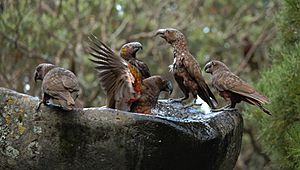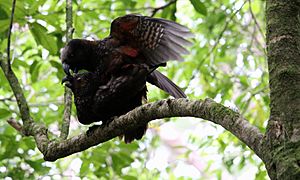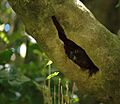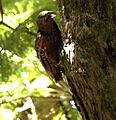Kākā facts for kids
Quick facts for kids New Zealand kākā |
|
|---|---|
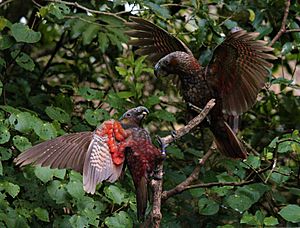 |
|
| A pair of North Island kākā in Zealandia, Wellington, New Zealand | |
| Conservation status | |
| Scientific classification | |
| Genus: |
Nestor
|
| Species: |
meridionalis
|
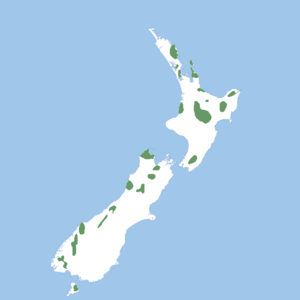 |
|
| Range in green | |
The New Zealand kākā (Nestor meridionalis) is a large parrot found in New Zealand's native forests. People often call it just kākā. However, this name is also used for two other kākā species that are now extinct: the Norfolk kākā and the Chatham kākā. There are two types, or subspecies, of New Zealand kākā. This bird is an endangered species. It has disappeared from many places where it used to live. But thanks to efforts like reintroducing them at Zealandia in Wellington, their numbers are growing in the city.
Contents
Understanding the Kākā's Name and Family
The New Zealand kākā was first officially described in 1788. This was done by a German scientist named Johann Friedrich Gmelin. He gave it the scientific name Psittacus meridionalis. The word meridionalis means "southern" in Latin. This name came from a "Southern brown parrot" that an English bird expert, John Latham, had described earlier.
Today, the New Zealand kākā is part of the genus Nestor. The Māori name kākā simply means "parrot". It might be linked to the sound "kā," which means 'to screech'.
Kākā Subspecies
There are two main types of New Zealand kākā:
- The North Island kākā (Nestor meridionalis septentrionalis)
- The South Island kākā (N. m. meridionalis)
Kākā's Closest Relatives
The Nestor genus includes four species:
- The New Zealand kākā (Nestor meridionalis)
- The kea (N. notabilis)
- The extinct Norfolk kākā (N. productus)
- The extinct Chatham kākā (N. chathamensis)
All these birds likely came from an ancient "proto-kākā" that lived in New Zealand's forests millions of years ago. Their closest living relative is the kākāpō (Strigops habroptilus). Together, they form a very old group of parrots called Strigopoidea.
What Does a Kākā Look Like?
The New Zealand kākā is a medium-sized parrot. It is about 45 cm (18 in) long. It weighs between 390 to 560 g (14 to 20 oz). It is closely related to the kea, but it has darker feathers. Kākā also spend more time in trees.
Their forehead and top of the head are greyish-white. The back of their neck is greyish-brown. Their neck and belly are more reddish. Their wings are brownish. Both types of kākā have feathers that are a mix of brown, green, and grey. They also have bright orange and scarlet flashes under their wings. Sometimes, you can even see kākā with red or yellow feathers, especially on their chest.
Kākā Calls
The kākā makes a harsh ka-aa sound. It also has a whistling u-wiia call.
Where Kākā Live
The New Zealand kākā lives in native forests, both in lowlands and at mid-altitudes. Their safest homes are currently on special island reserves. These include Kapiti Island, Codfish Island, and Little Barrier Island.
They are breeding quickly in the mainland island sanctuary at Zealandia. More than 800 birds have been tagged there since 2002. From Zealandia, North Island kākā are now moving back into Wellington city. A report from 2015 showed a big increase in their numbers over the past 12 years.
South Island Kākā Habitats
New Zealand kākā are still common in some large forested areas of the South Island. You can find them in:
- Rotoiti Nature Recovery Project
- Along the Milford Track
- In the Eglinton Valley in Fiordland National Park
Kākā also live around Stewart Island. They are also found on the offshore islands of Whenua Hou and Ulva Island. In 2015, kākā were released into Abel Tasman National Park. More were released there in 2019.
Kākā Behavior and Life Cycle
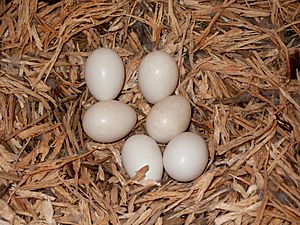
New Zealand kākā mostly live in trees. They stay in the middle to upper parts of the forest canopy. You often see them flying across valleys. They also call from the tops of tall trees. They are very social birds and move in large groups. These groups sometimes include kea, if kea are in the same area. Kākā are most active at dawn and dusk. You can sometimes hear them calling loudly during these times.
Kākā Reproduction
New Zealand kākā build their nests inside hollow trees. The entrance hole is usually three to six meters above the ground. However, on islands without predators, they might nest as low as ground level. The bottom of the nest is lined with small wood chips.
They lay eggs any time between September (late winter) and March (summer). If there is a lot of fruit one year, a pair might lay a second set of eggs. They often use the same nest hole for this. This can extend their breeding into winter. Kākā usually lay four eggs, but they can lay up to eight. Typically, two chicks will grow up and leave the nest. Only the female kākā sits on the eggs. She does this for about 24 days. She also takes care of the baby birds. The male kākā regularly brings her food while she is nesting. Both parents feed the chicks after they have left the nest.
What Kākā Eat
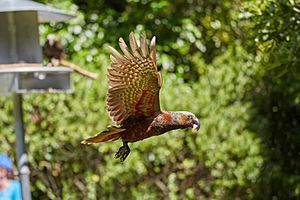

New Zealand kākā eat many different things. Their diet includes:
- Fruits
- Berries
- Seeds
- Flowers
- Buds
- Nectar
- Sap
- Plants
- Invertebrates (like insects)
They use their strong beak to break open the cones of the kauri tree to get the seeds. They have a special brush-like tongue to drink nectar. They also use their strong beak to dig out huhu beetle grubs. They can also remove bark to feed on tree sap.
Protecting the Kākā
New Zealand kākā are considered vulnerable. Their numbers have dropped a lot in their usual homes. This is because of:
- Habitat loss: Their forest homes are disappearing.
- Predators: New animals brought to New Zealand, like cats, rats, possums, and stoats, hunt kākā.
- Competition: Wasps and bees compete with kākā for honeydew. This is a sweet liquid from tiny insects called scale insects.
A similar species, the Norfolk kākā, became extinct in 1851 for similar reasons. The New Zealand kākā is fully protected by New Zealand law. It is also listed under an international agreement called CITES. This means importing or exporting kākā (or their parts) is controlled.
Threats from Predators
Kākā are especially at risk from predators. They nest in holes in trees and the mother stays on the nest for a long time (at least 90 days). Stoats are a big danger to nesting female kākā, their chicks, and young birds. Possums also hunt adult females, eggs, and chicks. There is strong proof that predators killing chicks and females has led to an uneven number of males and females, even in healthy kākā groups.
The Department of Conservation and local groups try to control these predators. They use traps, ground bait, and sometimes drop 1080 poison from the air. Where pest control has been done, kākā populations have recovered well. For example, in Pureora Forest Park, 20 kākā were tracked in an area treated with 1080. All 20 birds survived that season. In a nearby forest not treated, five out of nine tracked kākā were killed by predators.
Threats from Competition
Research shows that honeydew is very important for breeding kākā. This is especially true for those living in southern beech forests. It is very hard to control wasps, which compete for this food. This makes the future of the New Zealand kākā uncertain.
Kākā and People
Releasing North Island kākā at Zealandia, along with other conservation efforts, has led to more kākā in Wellington city. Many kākā now visit people's gardens and parks. This means more interactions between kākā and humans.
However, people have been feeding the birds unhealthy foods. These include nuts, various grains, and cheese. Feeding kākā these foods has caused a bone disease in kākā chicks. In 2016, 80% of the kākā chicks being watched by the Wellington City Council died from this disease. Kākā have also started nesting in the roofs of houses.
Images for kids
See also
 In Spanish: Nestor meridionalis para niños
In Spanish: Nestor meridionalis para niños



